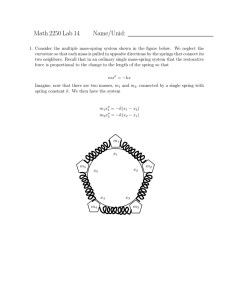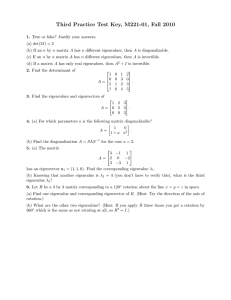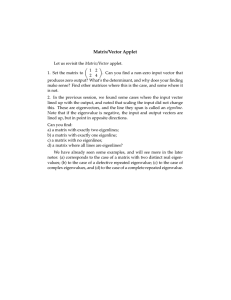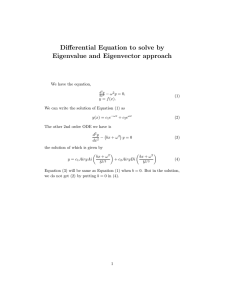Document 13562068
advertisement
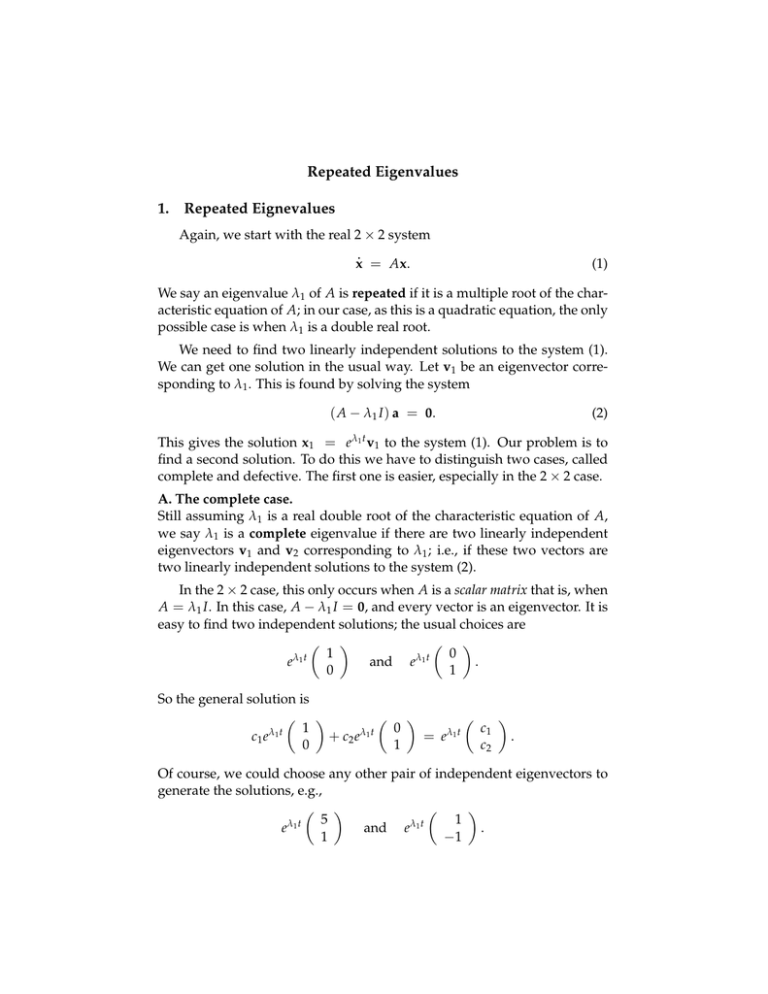
Repeated Eigenvalues 1. Repeated Eignevalues Again, we start with the real 2 × 2 system . x = Ax. (1) We say an eigenvalue λ1 of A is repeated if it is a multiple root of the char­ acteristic equation of A; in our case, as this is a quadratic equation, the only possible case is when λ1 is a double real root. We need to find two linearly independent solutions to the system (1). We can get one solution in the usual way. Let v1 be an eigenvector corre­ sponding to λ1 . This is found by solving the system ( A − λ1 I ) a = 0. (2) This gives the solution x1 = eλ1 t v1 to the system (1). Our problem is to find a second solution. To do this we have to distinguish two cases, called complete and defective. The first one is easier, especially in the 2 × 2 case. A. The complete case. Still assuming λ1 is a real double root of the characteristic equation of A, we say λ1 is a complete eigenvalue if there are two linearly independent eigenvectors v1 and v2 corresponding to λ1 ; i.e., if these two vectors are two linearly independent solutions to the system (2). In the 2 × 2 case, this only occurs when A is a scalar matrix that is, when A = λ1 I. In this case, A − λ1 I = 0, and every vector is an eigenvector. It is easy to find two independent solutions; the usual choices are � � � � 1 0 λ1 t λ1 t e and e . 0 1 So the general solution is � � � � � � 1 0 c1 λ1 t λ1 t λ1 t c1 e + c2 e = e . 0 1 c2 Of course, we could choose any other pair of independent eigenvectors to generate the solutions, e.g., � � � � 5 1 e λ1 t and eλ1 t . 1 −1 Repeated Eigenvalues OCW 18.03SC Remark. For n = 3 and above the situation is more complicated. We will not discuss it here. The interested reader can consult, for instance, the textbook by Edwards and Penney. B. The defective case. If the eigenvalue λ is a double root of the characteristic equation, but the system (2) has only one non-zero solution v1 (up to constant multiples), then the eigenvalue is said to be incomplete or defective and x1 = eλ1 t v1 is the unique normal mode. However, a second order system needs two independent solutions. Our experience with repeated roots in second order ODE’s suggests we try multiplying our normal solution by t. It turns out this doesn’t quite work, but it can be fixed as follows: a second independent solution is given by x2 = eλ1 t (tv1 + v2 ). (3) where v2 is any vector satisfying ( A − λ1 I ) v2 = v1 . (You can easily, if tediously, check by substitution that this does give a so­ lution. You need to remember that Av1 = λ1 v1 .) Fact. The equation for v2 is guaranteed to have a solution, provided that the eigenvalue λ1 really is defective. When solving for v2 = (b1 , b2 )T , try setting b1 = 0, and solving for b2 . If that does not work, try setting b2 = 0 and solving for b1 . Remarks 1. Some people do not bother with (3). When they encounter the defective case (at least when n = 2), they give up on eigenvalues, and simply solve the original system (1) by elimination. 2. Although we will not go into it in this course, there is a well developed theory of defective matrices which gives insight into where this formula comes from. You will learn about all this when you study linear algebra. We will now do a worked example. 2. Worked example: Defective Repeated Eigenvalue . � Problem. Solve u = Au, where A = −2 1 −1 0 � . Comments are given in italics. Solution. Step 0. Write down A − λI: � A − λI = 2 −2 − λ 1 −1 −λ � . Repeated Eigenvalues OCW 18.03SC Step 1. Find the characteristic equation of A: tr( A) = −2 + 0 = −2, det( A) = −2 × 0 − 1 × (−1) = 1. Thus, p A (λ) = det( A − λI ) = λ2 − tr( A)λ + det( A) = λ2 + 2λ + 1 = 0. Step 2. Find the eigenvalues of A. The characteristic polynomial factors: p A (λ) = (λ + 1)2 . This has a re­ peated root, λ1 = −1. As the matrix A is not the identity matrix, we must be in the defective repeated root case. Step 3. Find an eigenvector. This is vector v1 = ( a1 , a2 )T that must satisfy: � �� � � � −2 + 1 1 a1 0 ( A + I ) v1 = 0 ⇔ = −1 1 a2 0 � �� � � � −1 1 a1 0 ⇔ = . −1 1 a2 0 Check: this gives two identical equations, which is good. Setting a1 = 1 gives a2 = 1. Thus, The equation is − a1 + a2 = 0. one eigenvector for λ1 is v1 = (1, 1)T . All other eigenvectors for λ1 are multiples of this. Step 4. Find v2 : This vector v2 = (b1 , b2 )T must satisfy � ( A − λ1 I ) v2 = v1 ⇔ −1 1 −1 1 �� b1 b2 � � = 1 1 � ⇔ −b1 + b2 = 1. Setting b1 = 0 gives b2 = 1; so v2 = (0, 1)T is suitable. Step 5. General solution. The general solution is � � � � � � � � � � �� 1 1 0 1 1+t −t −t −t −t u ( t ) = c1 e + c2 (te +e = e c1 + c2 . 1 1 1 1 1 + 2t 3 MIT OpenCourseWare http://ocw.mit.edu 18.03SC Differential Equations�� Fall 2011 �� For information about citing these materials or our Terms of Use, visit: http://ocw.mit.edu/terms.




